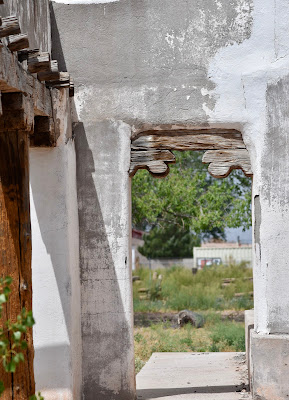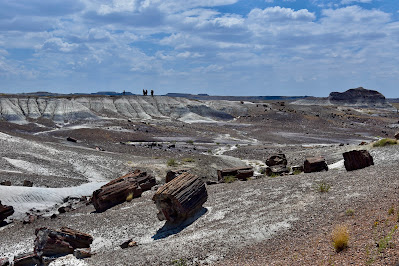Baby, it's hot out there
It's less than 500 miles from our Prescott home to Santa Fe, New Mexico, an easy enough day's drive; however, we opted for a one-night stopover in Holbrook to give us time with son Lewis from nearby Joseph City. We miss having the kids close at hand, so this stop was an alleviation for offspring-deprivation syndrome.
We were impressed with the patio he created and the little garden border and bird feeder, as were the quail that departed just prior to our arrival and the house sparrow that was availing itself of seeds on the ground. I'm maybe gonna remember to record a bird list during this trip, so starting now with the paltry few others we identified during the day: raven, turkey vulture, Swainson's hawk & rock wren, a fitting lineup for a brutally hot July day in the very arid region we traversed.
Ghosts of days past . . .
Likely because he's our son, having inherited the Kelley-curiosity-about-things-past, Lewis wanted to show us an interesting relic of Holbrook's heyday. In the midst of a once-prosperous few city blocks, a large long-abandoned structure exhibited evidence that Route 66 and railroad travelers once filled its rooms and expansive grounds with life.
The only life evident during our perusal was a young one-eyed cat peering back at us from beneath its leafy shelter.
With a bit of later research, I learned that the once-stately building is thought to be the oldest extant structure in Holbrook, and has a long multi-use history. It began circa 1881 as a private residence built by Pedro Montaño, and has been known variously during later iterations as the Arizona Rancho, Higgins House, Arizona Hotel and Brunswick Hotel. Its uses evolved over time from private residence to boarding house, hospital and motel as additions filled multiple needs of the era. It housed a Masonic Lodge and a dance hall as well as filling multiple other uses over time.
Its prime location between the railroad tracks and the Little Colorado River must have been desirable for a city center that has now relocated closer to the Interstate highway.
We enjoyed wandering the property's perimeter and speculating at the place's uses . . . and wondering if that was a slight movement behind the curtain at that upstairs window . . .
With that fascinating sidetrack . . .
. . . out of the way, we proceeded toward our destination: the Petrified Forest and Painted Desert. Oh, there was one other sidetrack (may it ever be) when we stopped for an extended gape & gawk through the most amazing and humongous private collection and for-sale array of fossils, crystals, rocks and petrified wood objects imaginable. The joke's on me: I can't even remember the name of the commercial enterprise, but I strongly suggest that if you ever pass by it on Highway 180 approaching the petrified forest, you stop - absolutely fascinating!
As sometimes happens, we eventually got to where we were headed, but by that time, hunger pangs suggested we lunch at the nice covered picnic area where ravens were on hand to clean up any droppings. It was so hot that the birds were all panting, or whatever equivalent birds do with their beaks agape.
Then . . . in the very hottest part of the day, we drove and walked through that bizarre and beautiful landscape where an ancient forest has transformed into a endless variety of stony colorful striations.
The 100-foot-long Agate Bridge, pictured below, spans a deep gully. It has long been one of the most-visited sites in the national park. As early as 1903, efforts were being made to support it with concrete pillars and now a concrete beam. It was a popular place to have one's photograph taken atop the span, an activity no longer allowed.
Our later-in-the-day arrival at the Painted Desert was slightly disappointing for photography because of hazy conditions.
I liked the juxtaposition of this vehicle relic where Route 66 crossed our road, with the old power poles marching alongside that storied highway and Interstate 40 truck traffic beyond.
We were one minute past the 4 p.m. closing to peruse the interior of the charming historic Painted Desert Inn, but it did not deter us from admiring its graceful exterior. The inn was constructed prior to 1920 and used as lodging for Route 66 travelers, revitalized by the Civilian Conservation Corps in the 1930s, and used later by the Fred Harvey company.
A very full very hot day: we were grateful to have the time together and that we did not allow the conditions to deter us.































No comments:
Post a Comment